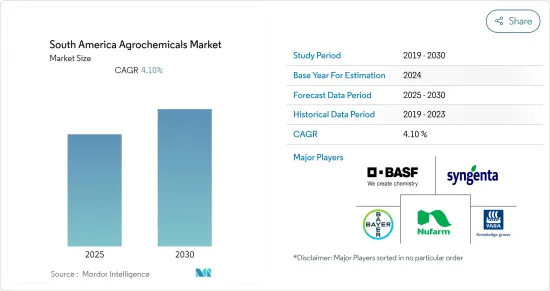 |
市場調查報告書
商品編碼
1683149
南美作物保護市場 -市場佔有率分析、行業趨勢和統計、成長預測(2025-2030 年)South America Agrochemicals - Market Share Analysis, Industry Trends & Statistics, Growth Forecasts (2025 - 2030) |
||||||
※ 本網頁內容可能與最新版本有所差異。詳細情況請與我們聯繫。
預測期內,南美作物保護市場預計複合年成長率為 4.1%

南美洲農化市場趨勢
農業部門成長
近年來,昆蟲、害蟲和植物寄生線蟲對作物保護化學物質等農藥產生了相當大的抗藥性。巴西和阿根廷是世界上成長最快的兩個作物保護市場。該地區的有機農業逐年成長,其中阿根廷佔據市場主導地位。阿根廷農業的很大一部分採用垂直整合系統,有機農業遍布全國。國際有機農業運動聯盟(IFOAM)在南美洲的永續農業和糧食安全努力中發揮關鍵作用。隨著有機農地的增加,該地區對生物農藥的需求也預計將增加。儘管目標害蟲的特異性有限,但它為該行業提供了許多機會,以促進永續農業,實現更健康的未來。微生物農藥各有其獨特之處,不僅在生物體和有效成分方面,而且在宿主、應用環境以及生產和控制的經濟性方面也各有不同。推動這些國家成長的主要作物是大豆和玉米。尋找永續的方式來養活快速成長的人口,同時滿足日益壯大的中階不斷變化的多樣化飲食需求,是南美洲可以利用的機會。因此,農藥供應在該地區發揮著至關重要的作用。
巴西佔市場主導地位
巴西是經濟快速成長的國家之一,也是全球最大的農化市場。該國作物保護化學品市場的快速成長歸因於對玉米和大豆出口的需求不斷增加,這導致這些作物的種植面積增加,從而導致作物保護化學品的使用量增加。由於亞洲銹病的不斷加劇,巴西成為2016年殺菌劑銷售量最大的國家。由於農藥非法貿易,2016 年該類別的銷售額與前一年同期比較有所下降。巴西從世界各地進口農藥,中國是巴西最大的農藥出口國。緊隨中國之後的是美國、印度、阿根廷等國家。
主要企業主導巴西作物保護市場,其中先正達在巴西作物保護銷售方面處於領先地位。拜耳和BASF分別位居第二和第三。先正達的 Viptera 增加了巴西玉米保護市場的參與企業。隨著人口不斷成長,國內糧食消費量也隨之增加,從而帶來農作物作物和相關投入的增加。更多採用高價值種子技術和購買相關種子保護產品作為保險。
南美洲農藥產業概況
新產品發布、併購和夥伴關係是市場主要企業採用的關鍵策略。這些公司還注重投資創新、合作和擴張,以增加市場佔有率。作物保護化學品市場主要分為主要企業:先正達公司、拜耳作物科學公司、雅苒巴西公司、BASF公司和 Nufarm 公司。 2017年,陶氏與杜邦合併順利完成。我們兩家公司的合併不僅代表著今天的巨大實力,也代表著未來的巨大機會。我們的綜合能力和生產創新引擎使我們能夠更快地將更廣泛的產品推向市場。此類活動可能會帶來市場整合。
其他福利
- Excel 格式的市場預測 (ME) 表
- 3 個月的分析師支持
目錄
第 1 章 簡介
- 研究假設和市場定義
- 研究範圍
第2章調查方法
第3章執行摘要
第4章 市場動態
- 市場概況
- 市場促進因素
- 市場限制
- 波特五力分析
- 供應商的議價能力
- 購買者和消費者的議價能力
- 新進入者的威脅
- 替代品的威脅
- 競爭對手之間的競爭強度
第5章 市場區隔
- 產品類型
- 肥料
- 農藥
- 佐劑
- 植物生長調節劑
- 應用
- 以作物為基礎
- 糧食
- 豆類和油籽
- 水果和蔬菜
- 非農作物
- 草坪和觀賞草
- 其他非農作物
- 以作物為基礎
- 地區
- 巴西
- 阿根廷
- 南美洲其他地區
第6章 競爭格局
- 最受歡迎的競爭策略
- 市場佔有率分析
- 公司簡介
- Syngenta
- Bayer CropScience AG
- BASF SE
- Corteva Agriscience
- Archer-Daniels-Midland(ADM)
- FMC Corporation
- Agrium
- Potash Corporation of Saskatchewan
- Nufarm Ltd
- FMC
- Yara International
第7章 市場機會與未來趨勢
第8章 新冠肺炎疫情的影響
The South America Agrochemicals Market is expected to register a CAGR of 4.1% during the forecast period.

South America Agrochemical Market Trends
Growth of The Agriculture Sector
In recent years, insects, pests, and plant-parasitic nematodes became immensely resistant against agrochemicals like the crop protection chemicals. Brazil and Argentina are the world's two fastest-growing agrochemical markets. Organic farming in the region is increasing year-after-year and Argentina holds the major share in the market followed by Uruguay and Brazil. An important part of agriculture in Argentina is organized in a vertically-integrated system and organic farming is found throughout the country. The International Federation of Organic Agriculture Movements (IFOAM) America Latina is playing a vital role in sustainable agriculture and food security initiatives in South America. With the increased organic farmland, demand for biological chemicals is also expected to increase in the region. Despite its limited target pest specificity, it offers many opportunities for industries to boost sustainable agriculture for a healthier future. Each microbial pesticide is unique, not only in an organism or active ingredient but also with the host, the environment in which it is being applied, and the economics of production and control. The main crops driving growth in these countries are soybeans and corn. Finding sustainable ways to feed the rapidly increasing population while satisfying the evolving and diverse dietary needs of the growing middle class is an opportunity that can be utilized by South America. Therefore, the provision of agrochemicals plays an important role in the region.
Brazil Dominates the Market
Brazil is one of the fastest-growing economies and the largest crop protection markets in the world. The rapid growth of the crop protection market in the country can be attributed to an increase in the export demand for corn and soybeans has increased the acreage of these crops, thus increasing the use of crop protection products. Due to the increased attack of Asian Rust in Brazil, fungicides constituted the most sold products in 2016. Due to the illegal trade of insecticides, the category witnessed a drop in sales in 2016 as compared to the previous year. Brazil also imports agrochemicals from across the globe in which China is the top-most exporter of agrochemicals in Brazil. China is followed by the United States, India, Argentina, etc.
Key players occupy the majority of the Brazilian agrochemical market with Syngenta leading the sales of agrochemicals in Brazil. Bayer and BASF occupy the second and third positions. Syngenta's Viptera led to an increase in its participation in the market for the protection of corn in Brazil. An increase in domestic food consumption by the expanding population increases produced crops and the associated inputs. Increase in the adoption of high-value seed technology and the related seed protectant products purchased as insurance policies.
South America Agrochemical Industry Overview
New product launches, mergers & acquisitions, and partnerships are the major strategies adopted by these leading companies in the market. These companies are also focusing on making an investment in innovations, collaborations, and expansions, in order to increase their market share. The agrochemicals market is fragmented, with key players being Syngenta AG, Bayer CropScience, Yara Brasil SA, BASF SE, and Nufarm. In 2017, Dow and DuPont merger was successfully completed. The merger of both companies is the biggest strength as of now as well as a great opportunity for the future. The combined capabilities and highly productive innovation engine will enable the company to bring a broader suite of products to the market faster. Such activities are likely to bring consolidation in the market.
Additional Benefits:
- The market estimate (ME) sheet in Excel format
- 3 months of analyst support
TABLE OF CONTENTS
1 INTRODUCTION
- 1.1 Study Assumptions & Market definition
- 1.2 Scope of the Study
2 RESEARCH METHODOLOGY
3 EXECUTIVE SUMMARY
4 MARKET DYNAMICS
- 4.1 Market Overview
- 4.2 Market Drivers
- 4.3 Market Restraints
- 4.4 Porter's Five Force Analysis
- 4.4.1 Bargaining Power of Suppliers
- 4.4.2 Bargaining Power of Buyers/Consumers
- 4.4.3 Threat of New Entrants
- 4.4.4 Threat of Substitute Products
- 4.4.5 Intensity of Competitive Rivalry
5 MARKET SEGMENTATION
- 5.1 Product Type
- 5.1.1 Fertilizers
- 5.1.2 Pesticides
- 5.1.3 Adjuvants
- 5.1.4 Plant Growth Regulators
- 5.2 Application
- 5.2.1 Crop Based
- 5.2.1.1 Grains and Cereals
- 5.2.1.2 Pulses and Oilseeds
- 5.2.1.3 Fruits and Vegetables
- 5.2.2 Non-Crop Based
- 5.2.2.1 Turf and Ornamental Grass
- 5.2.2.2 Other Non-crop Based
- 5.2.1 Crop Based
- 5.3 Geography
- 5.3.1 Brazil
- 5.3.2 Argentina
- 5.3.3 Rest of South America
6 COMPETITIVE LANDSCAPE
- 6.1 Most Adopted Competitor Strategies
- 6.2 Market Share Analysis
- 6.3 Company Profiles
- 6.3.1 Syngenta
- 6.3.2 Bayer CropScience AG
- 6.3.3 BASF SE
- 6.3.4 Corteva Agriscience
- 6.3.5 Archer-Daniels-Midland (ADM)
- 6.3.6 FMC Corporation
- 6.3.7 Agrium
- 6.3.8 Potash Corporation of Saskatchewan
- 6.3.9 Nufarm Ltd
- 6.3.10 FMC
- 6.3.11 Yara International








